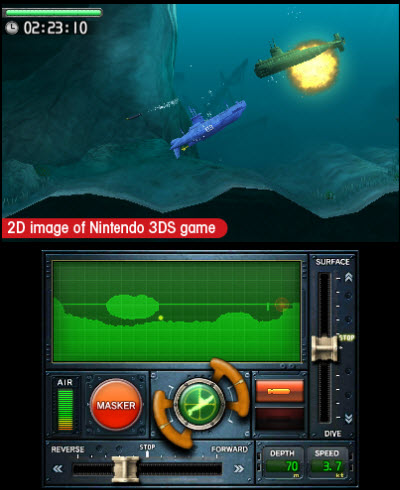
The game is kind of a critical one for Nintendo, since its new 3DS still seems to be lacking a flagship game capable of making the device competitive against the numerous smartphones and tablets already on the market that are quite capable of running high-quality, cheap games.
[aditude-amp id="flyingcarpet" targeting='{"env":"staging","page_type":"article","post_id":251430,"post_type":"story","post_chan":"none","tags":null,"ai":false,"category":"none","all_categories":"business,games,","session":"D"}']Steel Diver was in the works for a very long time, giving Nintendo time to hone the innovative graphics that really make the 3DS shine. You get a real sense of depth perception when you look at the screen. Unfortunately, this game could have been but isn’t quite the killer app for the 3DS — due to its lack of depth.
Like any other newly launched game system, the 3DS needs a cool game that early adopters can rave about to their friends, especially since Nintendo is charging $40 a game.
AI Weekly
The must-read newsletter for AI and Big Data industry written by Khari Johnson, Kyle Wiggers, and Seth Colaner.
Included with VentureBeat Insider and VentureBeat VIP memberships.
Nintendo showed off Steel Diver as one of the marquee games for the 3DS when it unveiled the system at the E3 trade show last year.
Steel Diver delivers on the visuals, but not on the mechanics of playing the game. As a result, I rate the game about 75 out of 100, which actually compares favorably to the average score of 58 on Metacritic, a game review aggregator.
Steel Diver did poke through one of my deeply held criticisms on the 3D visuals. I’m on the record as pretty much hating stereoscopic 3D, except in rare circumstances (like watching the film Avatar in 3D in theaters). I really don’t like the eye strain from the 3DS, even though it uses a novel technology to present images in 3D without the need for special glasses. But the 3D effect in Steel Diver is nicely done, and I haven’t gotten a headache yet even though I’ve played the game for multiple sessions. This is a big concession I’m making to Nintendo.
As you cruise through the ocean floor, the scenery is beautiful. You can easily perceive depth, in contrast to some of the other 3DS games. It feels as if you’re looking a couple of inches into the screen, as if you were looking into an aquarium (this makes me think that aquarium games might be cool on the 3DS). You can see schools of fish swimming around, either in the foreground or the background relative to your submarine. You can see plant life, ship wrecks and enemy ships at various angles, all creating the illusion of 3D. I could stare at the screen for 10-minute sessions without worrying about my eyes.
When you look at the environment, the background imagery is more like a still image, which is much easier to render against a moving submarine. The backgrounds are sharp and the colors are as vivid as I have ever seen in a handheld game. It all looked so cool, and it reminds me of some of the fun submarine games I’ve played in arcades and on the PC. That’s why I’ve given Steel Diver a relatively high score.
[aditude-amp id="medium1" targeting='{"env":"staging","page_type":"article","post_id":251430,"post_type":"story","post_chan":"none","tags":null,"ai":false,"category":"none","all_categories":"business,games,","session":"D"}']
The problem is that the whole collection of missions is too short. The game has a tiny amount of content. A determined player could get through the campaign in a day or two — especially if they don’t take the recommended break of 10 minutes of rest for every half hour of play. I don’t know why Nintendo didn’t add more levels to the game so you could feel like you’re getting your $40 worth.
Also, the submarine is very difficult to control with the stylus, since you have to hit the screen multiple times at once to keep your sub from careening into a cavern wall. At the same time, your sub can take a huge amount of damage and you can fix the damage simply by going to the surface. If you go to the surface, you lose valuable time (the missions are timed and you score better the faster you do them). But the surface-repair trick creates a great way to cheat. You can go to the surface and get your sub constantly repaired as you’re pummeled by surface ships. You just keep shooting torpedoes at the surface ships and you eventually win. I pulled this dirty trick to win easily.
I would have been much happier if the subs were easier to control and were destroyed with just a little bit of damage. As it is, you can take a direct hit from a torpedo, depth charge or a rock wall and survive it. There is a cool effect when you are damaged. Water leaks spring from the screen and you have to tap them with the stylus until they are plugged.
[aditude-amp id="medium2" targeting='{"env":"staging","page_type":"article","post_id":251430,"post_type":"story","post_chan":"none","tags":null,"ai":false,"category":"none","all_categories":"business,games,","session":"D"}']
You can also play against another player, using a local wireless connection. You get a top-down chess-like view of the game that puts you in command of a fleet of ships and a sub. Once you locate an enemy ship, you can enter periscope mode and blast it out of the water.
But the sad fact is that this game had a lot of unrealized potential. You might get excited about the underwater imagery for a little while. But once that wears off, you’re stuck with a game that doesn’t play that well and is too short.
VentureBeat's mission is to be a digital town square for technical decision-makers to gain knowledge about transformative enterprise technology and transact. Learn More
